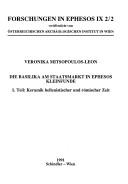| Listing 1 - 6 of 6 |
Sort by
|
Digital
ISBN: 9783540852261 Year: 2008 Publisher: Berlin, Heidelberg Springer-Verlag Berlin Heidelberg
Abstract | Keywords | Export | Availability | Bookmark
 Loading...
Loading...Choose an application
- Reference Manager
- EndNote
- RefWorks (Direct export to RefWorks)
Book
ISBN: 9783540852254 Year: 2008 Publisher: Berlin Springer
Abstract | Keywords | Export | Availability | Bookmark
 Loading...
Loading...Choose an application
- Reference Manager
- EndNote
- RefWorks (Direct export to RefWorks)
Book
ISBN: 128177295X 9786611772956 3540852263 3540852255 Year: 2008 Publisher: Berlin : Springer,
Abstract | Keywords | Export | Availability | Bookmark
 Loading...
Loading...Choose an application
- Reference Manager
- EndNote
- RefWorks (Direct export to RefWorks)
Proceedings of the14th European Microscopy Congress, held in Aachen, Germany, 1-5 September 2008. Jointly organised by the European Microscopy Society (EMS), the German Society for Electron Microscopy (DGE) and the local microscopists from RWTH Aachen University and the Research Centre Jülich, the congress brings together scientists from Europe and from all over the world. The scientific programme covers all recent developments in the three major areas of instrumentation and methods, materials science and life science.
Microscopy --- Physics. --- Physics, general. --- Natural philosophy --- Philosophy, Natural --- Physical sciences --- Dynamics
Book
ISBN: 9783540852261 Year: 2008 Publisher: Berlin, Heidelberg Springer-Verlag Berlin Heidelberg
Abstract | Keywords | Export | Availability | Bookmark
 Loading...
Loading...Choose an application
- Reference Manager
- EndNote
- RefWorks (Direct export to RefWorks)
Proceedings of the14th European Microscopy Congress, held in Aachen, Germany, 1-5 September 2008. Jointly organised by the European Microscopy Society (EMS), the German Society for Electron Microscopy (DGE) and the local microscopists from RWTH Aachen University and the Research Centre Jülich, the congress brings together scientists from Europe and from all over the world. The scientific programme covers all recent developments in the three major areas of instrumentation and methods, materials science and life science.


ISBN: 3700136323 9783700136323 9006258036328 Year: 2006 Volume: 13,2 Publisher: Wien Verlag der Österreichischen Akademie der Wissenschaften
Abstract | Keywords | Export | Availability | Bookmark
 Loading...
Loading...Choose an application
- Reference Manager
- EndNote
- RefWorks (Direct export to RefWorks)
Marketplaces --- Places du marché --- Ephesus (Extinct city) --- Ephèse (Ville ancienne) --- Places du marché --- Ephèse (Ville ancienne) --- Excavations (Archaeology) --- Antiquities --- E-books --- Excavations (Archaeology) - Turkey - Ephesus (Extinct city) --- Marketplaces - Turkey - Ephesus (Extinct city) --- Ephesus (Extinct city) - Antiquities


ISBN: 3900532281 9783700137337 3700137338 9783700139836 Year: 1991 Volume: 9,2,3 Publisher: Wien Schindler
Abstract | Keywords | Export | Availability | Bookmark
 Loading...
Loading...Choose an application
- Reference Manager
- EndNote
- RefWorks (Direct export to RefWorks)
Im Band FiE IX/2/3, 2. Teil, wird das bisher unpublizierte Fundmaterial aus den Grabungen der Basilika am Staatsmarkt der sechziger und siebziger Jahre des 20. Jhs. vorgestellt. Anhand der Dokumentation konnte einer der Vorgängerbauten der Basilika - eine Stoa - definiert werden, die um 200 v. Chr. errichtet wurde. Zwei verschiedene Füllschichten waren zu beobachten, eine unter dem Stylobat der hellenistischen Stoa, darüber eine 1,2 m hohe, um das Gehniveau der Basilika zu erhalten. Bis zur Gründung der hellenistischen Stadt lagen in diesem Areal Gräber entlang der Prozessionsstraße. Die Funde von Webgewichten, Gefäßmodeln, Matrizen sowie zahlreiche Lampen sind Belege für nachfolgende Siedlungen und Werkstätten. Den historischen Ereignissen entsprechend dominieren die rhodischen Amphoren das Fundmaterial des 3. Jhs. v. Chr., ehe sie von lokalen Produktionen abgelöst wurden. Etwa im letzten Viertel des 3. Jhs. wichen die privaten Bauten zugunsten der Stoa, die wiederum Ende des 1. Jhs. v. Chr. geschliffen wurde, um Platz für den Bau der Basilika zu schaffen. Einige der Funde wie Glas und Münzen belegen eine Nutzung bis in das 7. Jh. Gedruckt mit Unterstützung des Fonds zur Förderung der wissenschaftlichen Forschung
Basilicas (Roman architecture) --- Basiliques (Architecture romaine) --- Pottery, Ancient --- Céramique antique --- Ephesus (Extinct city) --- Ephèse (Ville ancienne) --- E-books
| Listing 1 - 6 of 6 |
Sort by
|

 Search
Search Feedback
Feedback About UniCat
About UniCat  Help
Help News
News